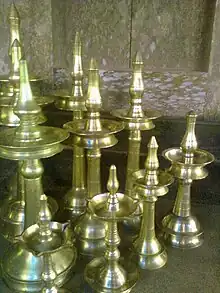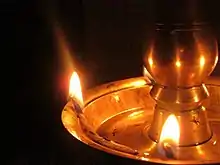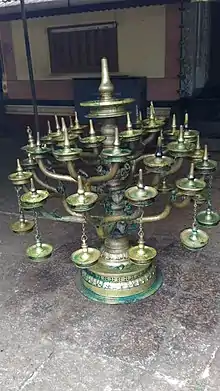
Nilavilakku ⓘis a traditional lamp used commonly in Kerala as well as in Tamil nadu (called Kuthuvillakku).[1] The traditional lamps which is lit during every auspicious occasions; in temples before the worship starts; at the official and unofficial functions.
Etymology




Nilam in the Malayalam/Tamil[1] language means floor or the ground and vilakku means lamp.
Usage
Original usage in Hinduism
The Nilavilakku is integral to several rituals and ceremonies in Hindu families in Kerala. As the sun sets, young girls of the family bring the lighted lamps to the verandah of the house, continued with evening prayers. In the evening the ritual is repeated alongside evening prayers. In Hindu temples, various types of Nilavilakku like 'Kutthuvilakku', 'Thookkuvilakku' etc are used and are very much related to the traditional beliefs and activities in Kerala.
Lighting the Nilavilakku on any occasion is believed to be auspicious. Nilavilakku plays an important role in the presentation of various art forms. The art forms are performed after lighting the lamp. In Kerala, many functions are inaugurated by lighting Nilavilakku.[2]
Nilavilakku is usually made of bronze or brass. Usually cotton wicks doused in oil or ghee are used for lighting the lamp. There are three ways of lighting the lamp. In one, only one wick is lit and is directed towards the deity or sacred space and in another there are two lit wicks in two directions. The third alternative is with five wicks in five directions.
Adoption by another religion
Christianity
With the reach of Christianity in Kerala, Saint Thomas Christians (or Syrian Christians) also started keeping Nilavilakku in their churches and homes. Traditionally, the nilavilakku is lighted and kept at the main front entrance of a home. Syrian Christian art forms like Margamkali and Parichamuttukali are performed around nilavilakku. A special type of Nilavilakku, called Aal Vilakku is used in Temples of South India, especially in Kerala.[3]
In Islam
It can also be found in certain Jarams in Kerala.
Ponmala Abdul Qadir Musliyar, secretary of Samastha Kerala Jem-iyyathul Ulama of AP Sunnis[4] quotes the Ibn Hajar's view on Muslims participating in the celebration and non-celebratory activity exclusive to non-Muslims.[5]
Since these are the signs of kufr (disbelief), it is indeed kufr if a Muslim does it imitating non-Muslims. On the other hand if doing it is with the only intention of participating in their celebration or the other (non-celebratory activity), without the intention of agreeing with signs of kufr, though it is not possible to judge he is a kafir, it is still sinful. If it happens unintentionally, without the intention of imitating or being similar to them anyway, one does not become a kafir for it nor does it become sinful.
Musliyar says that this Ibn Hajar's view itself is the ruling when a Muslim does something only done by non-Muslims and that the same applies to Muslims preparing special food on the festival day of non-Muslims. He also says that a Muslim would become a murthad (apostate) for lighting the nilavilak as a Hindu custom and that if Hindus' customs like lighting the nilavilak is done as an Indian custom, though the person does not become a murthad, it is still forbidden and sinful. Musliyar applies the same ruling on both lighting the nilavilak on public functions and breaking the coconut on public functions and adds that it is karahath[6] to do them unintentionally (without having the intention of being similar to non-Muslims or participating in it at all). He says that lighting the nilavilak is not an Indian tradition and that inaugurating public functions by breaking the coconut or by the carrying of thalappoli is a Hindu custom and thus sinful.[7]
Musliyar states the use of the nilavilak in Maqbaras are not imitation of the Hindus' custom. He explains that the nilavilak in Maqbaras are used solely for their material need while no special significance is given to it in the sense that it is a nilavilak.[8]
He also says the following about being considered a kafir based on one's belief:[9]
Similarly, performing sujood to the idol, wearing the poonul, wearing the rudraksha mala, lighting the lamp in front of an idol, a photo etc., are considered signs of hidden kufr (disbelief) in the heart. Because of doing these things, though one can say that one (the doer) is a kafir outwardly, but one will be a kafir in reality if one rejects what the rasul (Islamic prophet Muhammad) brought, in the heart.
The belt worn by Christian priests in the middle of their cassock, the Jews' cap, the Hindus' poonul etc., are external signs of kufr (disbelief); so the person who wears them is considered a kafir and dealt with him as a kafir. This is because such actions cannot stem from a person who fully accepts the prophet (Islamic prophet Muhammad). But if the prophet (Islamic prophet Muhammad) was fully accepted with the heart and apparently performed the signs of kufr (disbelief) for some other selfish interests, then he is not actually a Kafir in the sight of Allah (Shaikhzada 1/108, Hashiyyathunnihayah 1/113). But according to Islamic Shari'ah, he is considered a kafir in the material world.
See also
- Other lamps
- Related topics
References
- 1 2 RRV. "South Indian Traditional Nilavilakku 12 Inch tall". www.DanceCostumesAndJewelry.com. Retrieved 11 April 2018.
- ↑ "Nilavilakku - The Kerala's Traditional Oil Lamp - Neokerala". Neokerala. 21 June 2017. Retrieved 11 April 2018.
- ↑ |www.jaya-he.com/aal-vilakku
- ↑ "SSF clarifies on Sunni leader's remarks about religious freedom in India". The Hindu. 29 January 2023. ISSN 0971-751X. Archived from the original on 31 January 2023. Retrieved 28 July 2023.
- ↑ Ponmala Abdul Qadir Musliyar (2015). "Religious reasonabilities of nilavilak aversion". sunnivoice.net (in Malayalam). Archived from the original on 24 November 2018. Retrieved 28 July 2023.
- ↑ Bigya, p. 248.
- ↑ Ponmala Abdul Qadir Musliyar (2015). "Religious reasonabilities of nilavilak aversion". sunnivoice.net (in Malayalam). Archived from the original on 24 November 2018. Retrieved 28 July 2023.
- ↑ Ponmala Abdul Qadir Musliyar (2015). "Religious reasonabilities of nilavilak aversion". sunnivoice.net (in Malayalam). Archived from the original on 24 November 2018. Retrieved 28 July 2023.
- ↑ Ponmala Abdul Qadir Musliyar (2015). "Religious reasonabilities of nilavilak aversion". sunnivoice.net (in Malayalam). Archived from the original on 24 November 2018. Retrieved 28 July 2023.